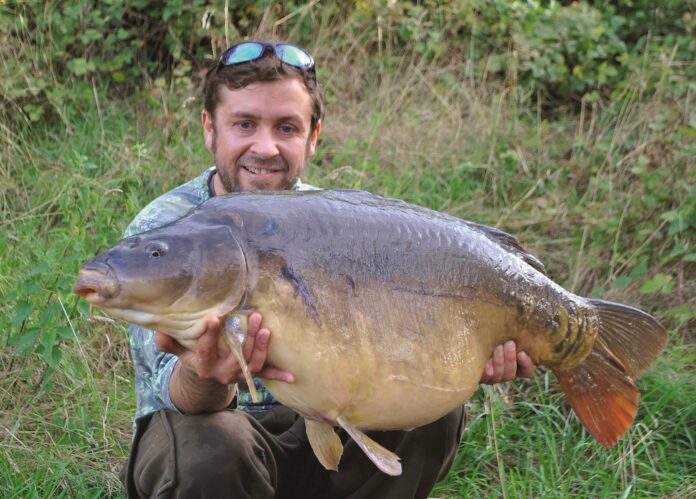
BY BEN HERVEY-MURRAY
Looking to get tight on some of this big carp you’ve seen in your local lake or park? Here are the baits you’ll need this spring and summer, based on my 30 years of carp fishing experience in Europe and California.
Sweetcorn
One of the most successful carp baits of all time, the golden grain has been the downfall of many a record carp in Europe and it remains an effective, easy-to-use bait that almost any carp will readily inhale.
The cheapest option is to buy in 1-pound bags frozen from the local supermarket, making sure to defrost it before using (some frozen corn floats…) and offer two or three grains on a size 6 or 8 hook over a handful of loose-fed offerings. Even better, but only if legal; go down to the lake a few hours beforehand and pre-bait with a bag or two of corn, returning when the carp are confidently feeding as dawn or dusk approaches.
The use of fake sweetcorn baits is also something to consider, and I found these particularly effective at avoiding rig-ruining turtles and terrapins when fishing park lakes. Carp will readily inhale plastic corn, especially when fished over a bed of real grains, but it’s important to use a hair rig with the bait well secured so it doesn’t come off and get eaten. Most fake corn floats, too, allowing for what is known as a pop-up presentation sitting just off bottom. Add a small shot to the leader an inch before the hook to keep it near the bottom and natural-looking.
A hair rig, by the way, is a reliable go-to presentation for many carp baits and consists of a small J hook tied to the line with snell-style knot, ideally a variant called a knotless knot, with a short piece of line extending below the hook with a tiny loop at the end. The bait is threaded up the line below the hook, ideally just touching the bottom of the hook bend, and is secured with a tiny plastic dumbbell on the loop, or tied on securely with specialist flavorless bait floss. A stack of two or three grains of corn topped with a fake piece of floating corn is an awesome presentation, even more so if the fake grain is white, pine or orange.
By the way, if you’re willing to soak and boil maize until it’s soft enough for consumption, this can be purchased in large sacks from animal feed stores and is a great option for serious pre-baiting campaigns, where allowed.
Bread
The go-to bait for surface-feeding carp, a matchbox-size chunk of crust with a size 6 or 4 hook buried inside will tempt many of those basking fish you’ll often see come summertime. Just watch out for ducks. A good tip is to put several slices of ready-sliced white bread in a sandwich bag in the microwave for 30 to 40 seconds before heading to the lake. This activates the gluten in the bread which makes for a much tougher bait that’ll cast further too.
Target margins, beside reed beds or wherever you see patrolling carp. Rig-wise, keep it simple with 8 to 15-pound mono straight through, taking care to grease the line a little so it floats (as you might if fishing a dry fly) and doesn’t sink to the bottom, dragging your bait towards to you and spooking wary carp.
Slim Jims
Carp love meaty, oily, spicey things and my secret bait in the UK for many years was a half-inch of a slim peperonni-style sausage, very much like a Slim Jim. So, I was delighted to find out that our California carp love this food type as much as their Euro cousins, readily inhaling little chunks of a Slim Jim fished on a short hair rig with a size 8 or 10 hook. Most preserved supermarket sausages be as effective – the more oilier and spicier the better.
Carp, generally, will find their food by detecting even the minutest food signals in the water, making baits that leach off pungent ingredients a good option. Have fun with this: maybe that off-brand, red-hot spicy frankfurter sat on your local grocery store counter will be your killer bait this summer, too?
Packbait
A common way of fishing for carp is to use a pack bait, which is a congealment of supermarket and animal feed ingredients, soaked and formed into a ball around a knobbly sinker designed to grip onto the packbait. Everyone has their own recipe for packbait but it usually revolves around processed oats, liquidized corn, fishery pellets, bread crumbs and similar ingredients that are left to soak overnight so they can be easily formed into a fist-sized ball for casting. The ball breaks down in the water, drawing carp to your hook bait.
A short hook link below the sinker with any of the hook baits mentioned in this article will work just fine. This is one to experiment with; work out what ingredients are available to you and, using a small quantity, build your own recipe to test. YouTube has some great tutorials on packbait recipes and mixing, by the way.
Boilies
Carp fishing in Europe revolves around boilies. Boilies are small balls made from various powders, eggs and attractants, mixed into a paste, rolled into balls ranging from 10 to 30 millimeters in diameter, and boiled (hence the name) for a minute or two to produce a firm but pungent food source. The advantages of boilies are that they’re not easily eaten by nuisance fish and other animals like crayfish, but they’re readily inhaled by carp. They can be cast a long way and imbibed with whatever flavors or attractants you like, too.
The easiest way to produce your own boilies at home is to use a semolina base mix. Simply add a couple of eggs, a dash of supermarket hemp oil (a very good all-round carp attractor), and a small amount of water to a pound of semolina, working it using the dough hook on a mixer until it’s smooth, not too sticky and not cracking when rolled into small 15-20 millimeter marbles. The color will be a nice natural light yellow.

Once you’ve converted the dough mix into small balls ready for boiling, lay them out on a tray and add 20 to 30 at a time to boiling water with a sieve, leaving them to boil for 90 seconds or until firm. Separate well, cool and dry for 24 hours in a dark room like a garage, whereupon you’ll have a few sessions worth of carp bonbons that will easily freeze for a few months in a ziplock. Mount one whole or two chopped in half back-to-back on a short hair rig over a handful of loose offerings and you’re in the game for a big carp or two.
Making your own bait is fun, but not without its hazards. In the mid-90s, when I started making my own boilies, I followed the above recipe but with the addition of something called Monster Crab. This was the go-to bait enhancement for many at the time, renowned for catching many big carp, but the smell was unholy. Imagine a dead crab sat in the sun for few days and then bottled, and you’re not even close to the smell my mom came home to one day after work. I was made to bury the bottle of Monster Crab in the garden, where it may still be to this day. So, go wild with your ingredients; fruity, meaty, oily flavors rarely go wrong. Just don’t stink the house out.



